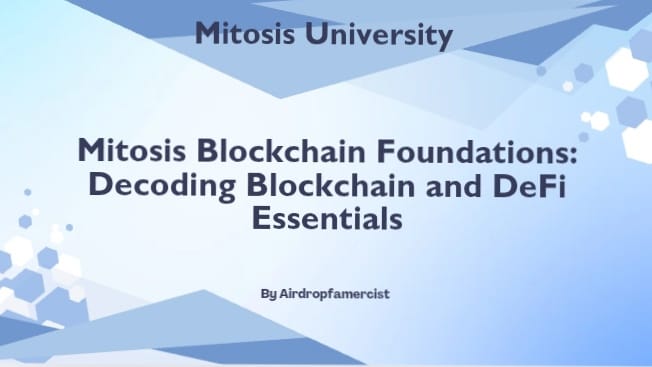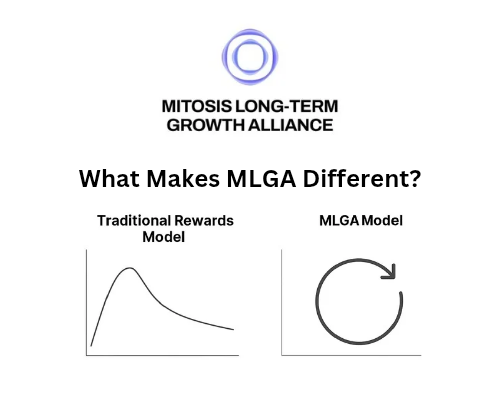Mitosis Blockchain Foundations: Decoding Blockchain and DeFi Essentials

Decentralized Finance (DeFi) and blockchain technology are reshaping finance, offering transparency and accessibility that challenge traditional systems. Mitosis, a Layer 1 blockchain, steps into this arena to solve a critical DeFi problem: liquidity fragmentation across multiple chains. To understand Mitosis’ impact, we need to grasp the core blockchain and DeFi concepts it builds upon.
This article offers an educational dive into these fundamentals, paired with technical insights into the multi-chain landscape Mitosis navigates, keeping things clear yet informative.
Blockchain Basics: The Core of Mitosis
A Blockchain is a decentralized, tamper-proof ledger that records transactions across a network of computers, eliminating the need for a central authority. Mitosis leverages this structure to enable seamless liquidity management.
Here’s what you need to know:
- Blocks and Chains: A blockchain is a series of blocks, each holding transactions, a timestamp, and a cryptographic hash linking to the prior block. This design ensures immutability—altering a block requires rewriting the entire chain, a near-impossible task. Mitosis, as a Layer 1, maintains its own ledger tailored for cross-chain operations.
- Consensus Mechanisms: Blockchains agree on their state via consensus algorithms. Proof of Work (PoW), like Bitcoin’s, uses computational power, while Proof of Stake (PoS), common in Ethereum, relies on staked assets for efficiency. Mitosis interacts with various chains, adapting to their consensus models to enable interoperability.
- Smart Contracts: These self-executing programs automate agreements on the blockchain. In DeFi, they power lending, trading, and more. Mitosis uses smart contracts to manage liquidity vaults and tokenize assets, creating flexible financial tools.
- Interoperability: Decentralization spreads control, but the rise of chains—Ethereum, Solana, Arbitrum—fragments liquidity. Mitosis bridges this gap by enabling assets to flow across networks, reducing reliance on clunky bridges.
These blockchain pillars—immutability, consensus, and automation—underpin Mitosis’ mission to unify DeFi liquidity.
DeFi Fundamentals: Where Mitosis Shines
DeFi builds financial services on blockchains, bypassing intermediaries for lending, trading, and yield generation. Mitosis targets liquidity, so let’s explore the DeFi concepts it engages:
- Liquidity Pools: DeFi relies on pools—smart contracts where users deposit assets to enable trading or lending. Automated Market Makers (AMMs) like Uniswap reward liquidity providers (LPs) with fees, but pools are chain-specific, locking capital. Mitosis’ Ecosystem-Owned Liquidity (EOL) pools assets across chains for broader use.
- Total Value Locked (TVL): TVL tracks assets in DeFi protocols, surpassing $100 billion in 2025. Fragmentation limits TVL’s impact on smaller chains. Mitosis boosts TVL by making liquidity accessible across ecosystems.
- Yield Farming: LPs earn rewards, often tokens, for supplying liquidity. Yields fluctuate, and impermanent loss—profit erosion from price swings—looms. Mitosis counters this by tokenizing liquidity, letting users optimize returns across protocols.
- Cross-Chain Barriers: Assets on one chain, like Ethereum, don’t easily move to Optimism, requiring slow, risky bridges. Mitosis streamlines this with tokenized assets, enhancing capital efficiency.
These dynamics highlight the liquidity challenges Mitosis tackles through technical innovation.
Mitosis’ Technical Framework: Programmable Liquidity
Mitosis addresses liquidity fragmentation with a Layer 1 blockchain designed for cross-chain DeFi. Its key innovation is Ecosystem-Owned Liquidity (EOL), where users deposit assets (e.g., ETH, USDC) into Mitosis Vaults on chains like Arbitrum or Scroll. They receive Vanilla Assets (e.g., vETH), 1:1 tokens usable across DeFi apps. These can be staked for miAssets, granting governance rights, or locked in campaigns for maAssets, yielding fixed rewards.
This setup solves multiple issues:
- Fragmentation: Capital locked in one chain’s protocol is siloed. Vanilla Assets act as universal wrappers, usable anywhere Mitosis operates.
- Static Capital: Traditional LPs lose flexibility post-deposit. Mitosis’ tokens can be redeployed, earning yields without withdrawal.
- Accessibility: High-yield deals often exclude retail users. EOL’s governance lets communities shape liquidity strategies, leveling access.
Mitosis’ settlement system syncs cross-chain activities, ensuring accurate yield tracking. For example, a user deposits weETH on Arbitrum, receives vweETH, and uses it in a Matrix Campaign for rewards. Governance might allocate the liquidity to a lending pool on Scroll, with profits flowing back seamlessly. This avoids bridge inefficiencies, reducing fees and latency.
Programmable liquidity is Mitosis’ edge. Vanilla Assets can be collateralized, hedged, or staked, enabling strategies like borrowing against LP tokens or optimizing yields across AMMs. Matrix Campaigns curate premium opportunities, rewarding locked assets transparently. As a Layer 1, Mitosis likely uses PoS for scalability, with audited smart contracts to minimize risks, though cross-chain complexity demands vigilance.
Why Mitosis Matters
Mitosis competes with AMMs like Uniswap and interoperability solutions like Chainlink’s CCIP, carving a niche in programmable, cross-chain liquidity. Its $7 million funding and partnerships (e.g., Ether.fi) signal momentum. For users, it unlocks DeFi’s full potential; for emerging chains, it boosts TVL and adoption.
Risks persist—smart contract bugs, governance imbalances, or market volatility could disrupt. Yet Mitosis’ vision of fluid, community-driven liquidity positions it as a DeFi innovator.
Mitosis reimagines liquidity as a dynamic, chain-agnostic asset, built on blockchain’s core—decentralization, automation, immutability. By tackling fragmentation, it empowers users and ecosystems alike. Dive into its vaults or community to explore EOL firsthand.

Comments ()